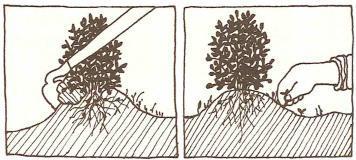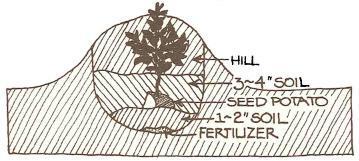Caring for potatoes requires proper watering, cultivating and hilling.
CultivationStirring up the soil on the surface keeps it loose so that the plants' roots can get water and air. They have to drink and breathe just as we do. Whenever the soil becomes packed or crusty, raking the top inch of soil lightly can help.
If you hill your potatoes during the first four to eight weeks after planting, you shouldn't have any problems with weeds. Hilling buries weeds near the plants, and it usually takes care of most walkway weeds, too.
Once the hills are made, though, don't disturb them with a hoe or any other tool. If you want to remove some weeds, pull them by hand.

There are several reasons why you must pull soil up around the stems of your potato plants, or "hill" them, once or twice during the season:
* The additional loose soil allows the developing tubers to expand easily.
* Hilling helps to keep the potatoes from poking through the soil and becoming "green" from the sun. ("Greening" gives them a bitter flavor.)
* Hilling buries and kills weeds around the plants before they become a serious problem.
* Rain collects in gardens with heavy soils, blocking the flow of air to the plant roots. However, a hilled row of potatoes sheds water. Hilling keeps the plants better drained and more productive because the earth doesn't pack around them.
* Pulling soil from between the rows up around the plants creates a natural irrigation ditch.
Hill the plants for the first time about a week after they poke through the soil. Do the job with a hoe or a tiller with a hilling attachment, and pull up as much soil as you can around the stems. If you cover some, or even all, of the leaves of the plants, don't worry about it. They'll push back through in a few days. In fact, if your early planted potatoes are up and there's a chance of a late frost, you can cover the plants entirely to protect them from injury. Potatoes can take a light frost; burying them is just added insurance.
Do the second hilling three or four weeks later, before the potato vines spill out into the walkways.

Potatoes need a steady, season-long supply of water, but it's most important 6 to 10 weeks after planting, when the plants start to develop their tubers.
An uneven water supply can cause knobs or growth cracks in potatoes. If the plants don't get enough water, the tubers won't grow and their cells will start to mature. Then, when a sudden increase in water does occur, the potatoes start a second, new growth, causing the tubers to crack or develop into odd shapes.
Deep Watering is BestPotatoes can take some periods of dry weather. However, if it's been very dry and the tubers are beginning to develop underground, water the plants. If you need to water, be sure you do a thorough job, applying enough to moisten the soil 8- to 10-inches below ground. Deep watering is the only way to go. Research shows that irrigated potatoes obtain 57 percent of their water from the top foot of soil, 24 percent from the second foot of soil and as much as 13 percent from the third foot of soil. Though the potato plant is mostly shallow-rooted, some roots do indeed go deep for water.
 Victory Seed Company has all the seeds you want for your best garden in 2024.
Victory Seed Company has all the seeds you want for your best garden in 2024.
For 25 years, the family-owned Victory Seed Company has provided the highest quality vegetable, herb and flower seeds to families across the country. We are passionate about providing you the best seeds available that give excellent germination, robust plants, and the harvest you want. With a catalog of over a thousand varieties, we have everything, and our prices are the kinds that we'd want to pay. We have hundreds of yesterday's heirloom vegetables, as well as today's award winning hybrid selections. Get to know us by visiting our website and browsing through our online vegetable seed catalog.
| 1. Caring for Potatoes ← you're on this article right now |
| 2. Potato Pests and Diseases |
| 3. Sweet Potato Rx |
| 4. Sweet Potato Care |
| 5. Fertilizing Potatoes |
| 1. Caring for Potatoes ← you're on this article right now |
| 2. Potato Pests and Diseases |
| 3. Sweet Potato Rx |
| 4. Sweet Potato Care |
| 5. Fertilizing Potatoes |